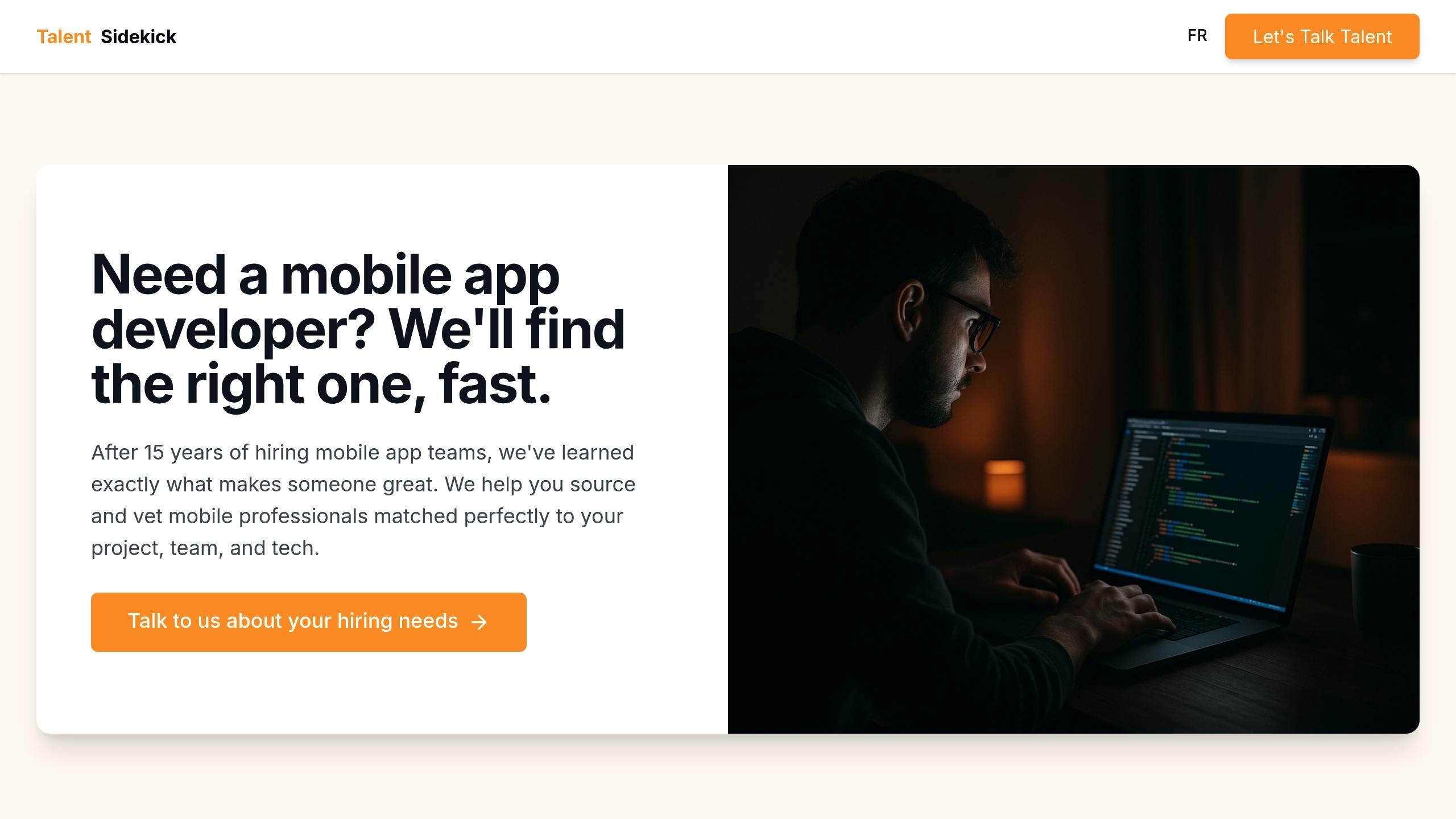
When deciding between hiring an in-house team or working with a mobile staffing agency for app development, the choice depends on your budget, timeline, and project needs. Here’s a quick breakdown:
- In-house teams: Offer direct control and alignment with your company’s goals. However, they are expensive to maintain, with annual costs ranging from $550,000 to $830,000 for a small team. Hiring, training, and retaining talent can also be challenging, especially in a tight labor market.
- Mobile staffing agencies: Provide access to pre-vetted developers at predictable costs, often 40%-60% cheaper than in-house teams. They allow for quick scalability and access to specialized skills, but you may have less direct control over the process.
Quick Comparison
| Factor | In-House Team | Mobile Staffing Agency |
|---|---|---|
| Annual Cost | $550,000 – $830,000 | $72,000 – $210,000 (first year) |
| Control | Full control | Limited control |
| Expertise Access | Limited to internal team | Broad, specialized talent |
| Scalability | Slower, hiring takes time | Fast, flexible scaling |
| Communication | Direct, real-time | May involve time zone delays |
If you need long-term control and plan to build multiple apps, an in-house team might be worth the investment. For cost savings, faster hiring, and access to diverse expertise, mobile staffing agencies are a better fit. Make your decision based on your project’s complexity, budget, and timeline.
Should You Build In-House or Hire an Agency?
1. In-House Mobile App Development Team
Choosing to build an in-house mobile app development team involves hiring developers as full-time employees. While this approach gives you direct control over the development process, it also comes with hefty financial commitments and operational challenges that go beyond just paying salaries.
Cost
Hiring in-house developers is expensive. A mid-level developer typically earns between $100,000 and $130,000 annually, with senior developers often earning over $150,000. On top of that, you need to account for benefits (20%–30% of salary), hiring costs (around $4,000 per hire), and infrastructure expenses (ranging from $5,000 to $10,000 per year). Altogether, the total cost per developer can range from $85,000 to well over $150,000 annually.
There are also hidden costs to consider. For instance, developers may be underutilized during slower periods, leading to wasted resources. High turnover rates can result in rehiring and retraining expenses, and downtime during vacations or sick leave can delay projects. These factors can significantly stretch your budget and complicate timelines.
Scalability
Scaling an in-house team brings its own set of challenges. Job postings for developers have nearly doubled in recent years, while the number of applicants has dropped, making it harder to find skilled professionals quickly. This talent shortage can delay your ability to scale up for new projects.
Additionally, fluctuating project demands can make in-house teams inefficient. During quiet periods, you’re still paying full salaries for developers who may not have enough work. On the flip side, when urgent needs arise, the lengthy hiring process can slow down your ability to bring in additional expertise.
Access to Expertise
Modern mobile app development requires a broad range of skills, which can be tough for in-house teams to cover. Developers need to be proficient in both iOS and Android platforms, as well as backend integration. Keeping up with the rapid pace of technological advancements also requires ongoing investment in training to ensure your team stays up-to-date.
Control and Team Fit
One of the biggest advantages of in-house development is the level of control you have. Your team is fully immersed in your company culture, which helps align goals, streamline decision-making, and ensure accountability.
In-house developers work closely with your existing workflows and processes. They’re available during regular business hours, attend internal meetings, and develop institutional knowledge that can benefit long-term projects. However, managing an in-house team also means taking on the responsibility of handling technical talent. This requires HR expertise and leadership skills, which your organization might not always have readily available.
2. Mobile Staffing Agency (e.g., Talent Sidekick by Sidekick Interactive)
Working with a mobile staffing agency offers a fresh alternative to managing an in-house team. Instead of hiring full-time employees, you gain access to a pool of pre-vetted developers who seamlessly integrate into your operations. This approach is becoming increasingly popular, with the global mobile app development outsourcing market expected to hit $781.70 billion by 2029, growing at an annual rate of 7.84% between 2025 and 2029.
Cost
One of the biggest advantages of mobile staffing agencies is cost predictability. Their hourly rates typically range from $25 to $200, with total project costs varying between $20,000 and $200,000+. This pricing structure eliminates many of the hidden expenses tied to full-time employees, such as office space, equipment, software licenses, and HR overhead.
Geographic flexibility also plays a pivotal role in reducing costs. For instance, developers in Eastern Europe or Asia often charge between $20–$50 per hour, compared to the $100–$150 per hour rate for U.S.-based in-house developers. This difference can lead to substantial savings, allowing you to allocate resources more efficiently without sacrificing quality.
Scalability
Mobile staffing agencies are known for their ability to scale teams quickly. With agencies deploying around 16 million workers annually and three million temporary or contract employees active in any given week, they can adjust to your project needs in no time. Whether you’re facing a tight deadline or a seasonal surge in workload, you can expand your team rapidly and downsize just as easily when the project slows down.
This flexibility is especially useful for startups or businesses with fluctuating demands. You avoid the lengthy hiring processes and severance costs tied to permanent staff while still gaining access to specialized talent when you need it most. Agencies ensure that every project gets the attention it deserves by tapping into their extensive networks of skilled professionals.
Access to Expertise
Mobile staffing agencies maintain large databases filled with highly qualified candidates. They stay on top of hiring trends and use their expertise to match you with developers who meet your specific needs. This is critical in today’s market, where 61% of HR professionals report challenges in finding qualified developers.
Take Talent Sidekick by Sidekick Interactive as an example. With 14 years of mobile development experience, they use senior-level experts to vet candidates thoroughly. This ensures you’re connected with developers who not only have the technical skills to deliver high-quality apps but also align with your project’s goals.
Beyond technical know-how, agencies often provide valuable insights into industry trends and market demands. They can even assess how well candidates fit within your company’s culture, ensuring a smoother integration into your team.
Control and Team Fit
While working with a staffing agency may offer less direct control than managing an in-house team, reputable agencies prioritize alignment with your company’s culture and project requirements. They focus on understanding your HR goals through clear communication and tailored recruitment strategies.
"Effective staffing partnerships are built on clear communication and mutual understanding." – Harvard Business Review
sbb-itb-7af2948
Pros and Cons
When deciding between in-house teams and mobile staffing agencies, it’s essential to weigh the advantages and challenges of each approach. Both offer distinct benefits, and the choice ultimately depends on the specific needs and constraints of your project.
In-house teams give you full control over the development process, allowing for direct oversight of daily operations and alignment with your company’s goals. They also offer enhanced data security, particularly useful when handling sensitive information. Over time, an internal team gains a deep understanding of your business, enabling them to deliver highly tailored solutions.
However, maintaining an in-house team comes with steep financial commitments. For instance, a basic team of 4–5 developers can cost between $550,000 and $830,000 annually, factoring in salaries ($400,000–$600,000), infrastructure ($50,000–$80,000), and benefits ($100,000–$150,000). Additionally, finding qualified developers is a significant challenge – 61% of HR professionals report difficulties in this area. This can limit your team’s ability to pivot or adopt emerging technologies.
On the other hand, mobile staffing agencies provide access to a wide range of specialized expertise without the overhead costs of full-time employees. Outsourcing can reduce development costs by 40%–60%. For example, a complex enterprise application that might cost $830,000 annually with an in-house team could be developed for $72,000 to $210,000 in the first year through a staffing agency.
The downside of using mobile staffing agencies is the reduced direct control over the development process. However, reputable agencies, such as Talent Sidekick by Sidekick Interactive, address this by leveraging senior experts with over 14 years of experience to ensure candidates meet both technical and cultural expectations.
| Factor | In-House Team | Mobile Staffing Agency |
|---|---|---|
| Annual Cost | $550,000 – $830,000 | $72,000 – $210,000 (first year) |
| Control Level | Full control over process | Less direct control |
| Expertise Access | Limited to internal skills | Broad talent pool access |
| Scalability | Slower hiring/firing | Rapid team scaling |
| Communication | Real-time, direct | Possible delays (time zones) |
The global shortage of software developers adds another layer of complexity. In 2021, there was a shortfall of 1.4 million full-time developers, and this gap is expected to grow to 4 million by 2025. This makes it increasingly difficult to build comprehensive in-house teams, especially for specialized areas like augmented reality or blockchain.
"With an in-house team, you have complete control over the development process, from hiring to direct oversight of daily operations." – Full Scale
While in-house teams offer unmatched control and alignment, they come with additional costs, such as attrition, infrastructure depreciation, and HR overhead. Hiring a new employee alone can cost 21% of their annual salary. On the flip side, outsourcing can lead to unexpected expenses, such as third-party services or ongoing maintenance for multi-platform projects.
Ultimately, your decision should be guided by your project’s complexity, timeline, and long-term objectives. In-house teams excel when face-to-face collaboration or strict compliance is crucial. Meanwhile, mobile staffing agencies are ideal for projects prioritizing cost savings, faster hiring, and scalability.
Conclusion
Choosing between an in-house team and a mobile staffing agency comes down to your business priorities, budget, and long-term goals. Each option has its own strengths, making it suitable for different scenarios.
In-house teams are ideal when you need full control over the development process, have strict security requirements for handling sensitive data, or plan to develop multiple mobile apps over time. This route works best for companies with solid technical leadership and the ability to manage ongoing infrastructure and operational expenses.
On the other hand, mobile staffing agencies, such as Talent Sidekick by Sidekick Interactive, are a great fit for businesses looking for cost-effective solutions, access to specialized skills, and the ability to scale quickly. These agencies also offer the flexibility to adapt to changing project demands without the long-term commitments of hiring full-time staff.
Scalability is becoming increasingly important. For instance, the application modernization market is expected to grow from $16.4 billion in 2023 to $43.9 billion by 2032. Agencies often bring expertise in cloud-native frameworks, microservices, and auto-scaling technologies that can help future-proof your app. Additionally, the global mobile app market is projected to exceed 175 billion downloads by 2026. These trends highlight the importance of aligning your development strategy with market demands.
Ultimately, the decision boils down to balancing control and flexibility. Startups with tighter budgets may benefit from the adaptability and cost savings of staffing agencies, while larger enterprises with established IT departments might gain more value from an in-house team. Carefully evaluate your current capabilities, growth plans, and risk tolerance to ensure your development strategy supports your overall business goals.
FAQs
What should I consider when choosing between hiring an in-house team and partnering with a mobile staffing agency for app development?
When choosing between building an in-house team or partnering with a mobile staffing agency for app development, you’ll need to weigh factors like control, cost, flexibility, and expertise.
An in-house team offers more control over the development process, ensuring closer alignment with your company’s goals and maintaining tighter security. However, this route demands a hefty investment in recruitment, training, and infrastructure. It’s not just about money – it also takes time and ongoing resources to manage and sustain.
On the flip side, a mobile staffing agency can provide specialized talent quickly, allowing you to scale your team as your project demands without committing to long-term hires. This option is often more budget-friendly for short-term or highly specific projects, though you may have less direct oversight of daily operations.
The right choice depends on your project’s scope, timeline, budget, and future support needs. For instance, if you’re working on a single app with a tight deadline, a staffing agency might be the smarter move. But if you’re planning multiple apps or need ongoing updates and support, an in-house team could prove more practical in the long run.
What are the cost differences between hiring an in-house team and working with a mobile staffing agency, and are there hidden expenses to consider?
Hiring an in-house mobile app development team in the U.S. comes with a hefty price tag. On average, recruitment costs alone are about $4,000 per hire, and developers typically charge anywhere from $25 to $150+ per hour. Depending on how complex the project is, total expenses can range from $40,000 to over $180,000. And that’s not all – there are other costs to consider, like recruitment fees, delays during onboarding, employee turnover, management overhead, and ongoing training. These hidden expenses can pile up fast.
Alternatively, working with a mobile staffing agency can offer a more flexible and scalable approach. Outsourcing costs for simpler apps might start at around $6,000, while more intricate projects can climb to $260,000. The advantage here is the agency’s ability to cut down on hidden costs. They handle staffing efficiently, eliminate recruitment delays, and provide professionals who are ready to hit the ground running. For businesses with fluctuating project demands or limited internal resources, this can be a smart and cost-effective solution.
What are the pros and cons of control and scalability when deciding between an in-house team and a mobile staffing agency?
Choosing between building an in-house team or partnering with a mobile staffing agency comes down to how much control and scalability you need. With an in-house team, you gain hands-on oversight, smoother communication, and a team that’s closely aligned with your company’s goals. But this approach often comes with higher costs, longer hiring timelines, and the ongoing responsibility of training and managing staff – making it less adaptable to rapid changes.
In contrast, a mobile staffing agency provides more flexibility and allows for faster scaling, which is ideal for adjusting to shifting project needs. They take care of recruitment and onboarding, easing your workload in those areas. However, you may have to compromise on direct control over daily operations and how the development process unfolds. To make the right choice, weigh your project’s timeline, budget, and long-term objectives carefully.


